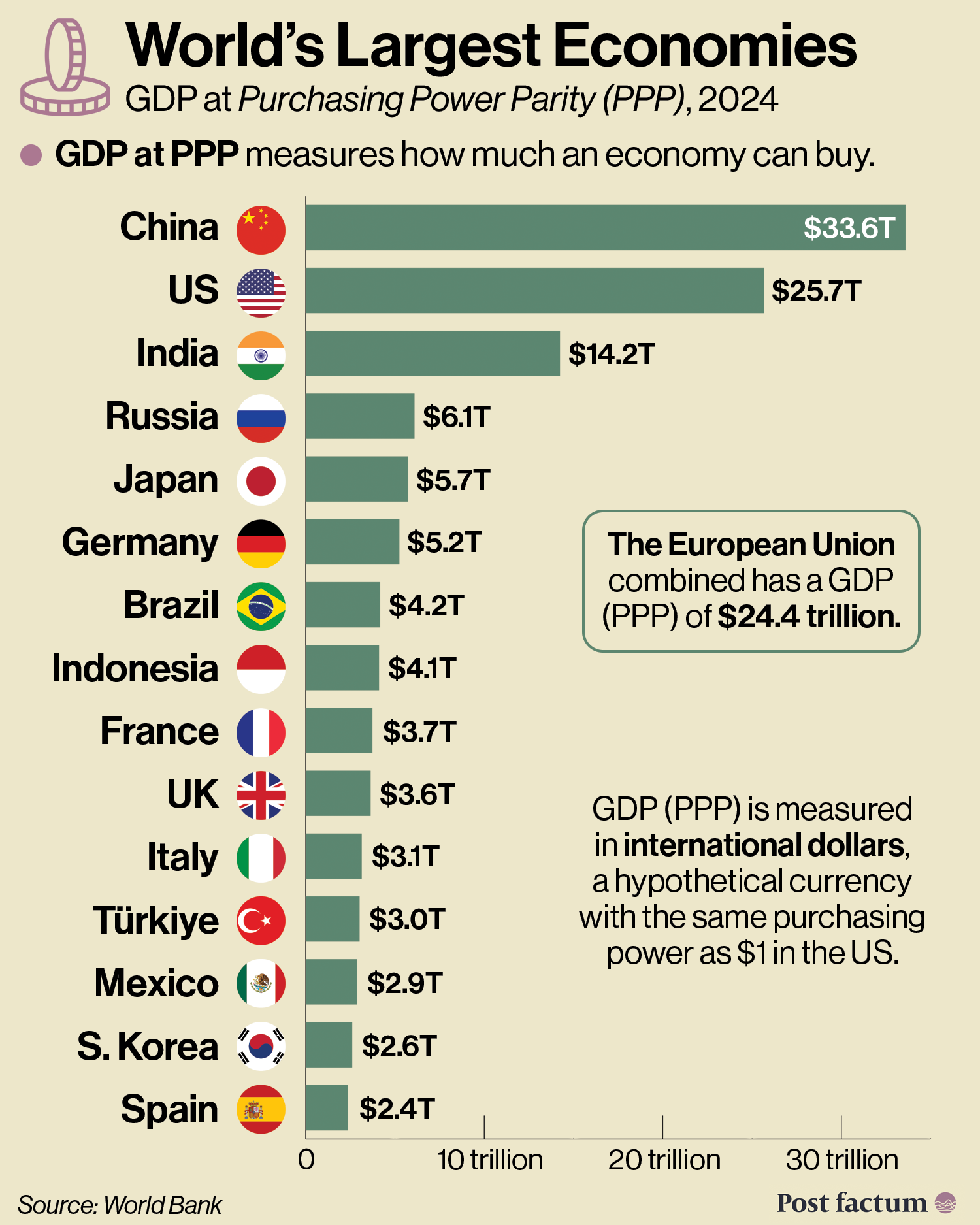GDP, explained
November 9, 2025
GDP (Gross Domestic Product) is used to measure the size of economies and their growth.
It counts the value of all the products and services made within a country in a year.
It includes:
Consumer spending
Business spending
Government spending
Trade: exports minus imports
It can also be measured by adding up all incomes earned within the country.
What is not included in GDP?
Resold goods, like materials and ingredients for something else
Unrecorded activity, like black market sales or housework
Natural resources like oil reserves, or non-material assets like clean environment and health.
GDP includes spending on destructive wars or polluting industries, ignoring any negative side effects (externalities).
To compare countries, GDP is converted into dollars using current exchange rates. This is also called nominal GDP.
The US has the largest nominal GDP with $29 trillion. China is second with $19T, while the EU collectively also has around $19T.
Nominal GDP does not account for the difference in how much $1 can buy in different countries.
For example, a Big Mac costs $8 in Switzerland, $6 in the US, and $3 in South Africa. Purchasing Power Parity (PPP) takes this into account when measuring GDP.
GDP at PPP measures how much an economy can buy, correcting for international price and currency differences.
China is the largest economy by GDP (PPP) at $34T. The US is second with $26T.
The collective EU measures at $24T, and India follows with $14T.
GDP per capita
To see how productive people are on average, GDP can be divided by the country’s population, giving GDP per capita.
This does not show how incomes are distributed between people.
Countries are labelled as low, middle, or high-income, reflecting their productivity and standards of living.
High-income countries are sometimes called “developed”, while the low- and middle-income ones are referred to as “developing” or “emerging economies”.
Economic growth
Economic growth is the increase in GDP over time. It is calculated using real GDP.
Real GDP corrects nominal GDP for inflation, so that GDP is not showing price increases as growth.
Growth means the economy produces more goods and services, but this does not take into account how useful they are.
For example, government spending on weapons or soldiers’ contracts boosts GDP but may not create economic value.
Historically, investing in weapons sometimes paid off with the capture of foreign land, resources or even people.
For most countries, military spending also provides defence.
Extensive growth comes from adding more inputs like work, money, equipment, or land into the economy.
Intensive growth comes from using existing inputs more productively, often through innovation.
One country’s growth does not create another country’s loss:
China’s rise in manufacturing over recent decades didn’t stop the US or the EU from growing in services and technology.
The world’s GDP (PPP) has increased by more than 6 times since 1990, showing that many economies can grow together.
Countries with higher incomes and living standards tend to grow slower:
Their populations are aging, so fewer people work and spend.
Their economies are already industrial, so productivity is harder to improve.
They often have higher debt, which limits new investment.
In 2025, the US economy grew by 2%, while the EU grew by 1% on average.
Low- and middle-income countries usually grow faster:
They have younger and growing populations.
They benefit from catch-up effects: countries can use innovations from more developed states (such as by importing equipment)
Marginal gains: at lower GDP, extra productivity makes up a larger share of the total.
India is one of the fastest-growing economies (at 6%) but also one of the largest.
China grew by 4% in 2025 (down from a peak of 14% in 2007).
As discussed, GDP and economic growth don’t tell the full story on progress and development:
Alternative measures
Human Development Index (HDI) includes different metrics on standards of living, incomes, education and health.
Iceland leads the ranking, followed by Norway, Switzerland, Denmark and Sweden.
The World Happiness Index ranks countries by how their citizens rate their life satisfaction.
It considers income, freedom to make life choices, trust in the government, health and more.
Since 2018, Finland and Denmark have ranked the happiest.
The Economic Complexity Index (ECI) shows how varied and advanced a country’s exports are.
A higher score means the country has the skills to produce more complex goods.
Japan, Taiwan, Switzerland, South Korea and Germany are the top 5. The US ranks 10th, and China is 21st.
Military spending as a share of GDP is a rough indicator of a country’s defensive (and offensive) capabilities.
High levels in Ukraine (35% of GDP), Israel (9%) and Russia (7%) reflect wartime needs.
In countries like Saudi Arabia (7%) and Algeria (8%) high spending shows regional tensions.
NATO members were committed to spending at least 2% of their GDP on defence (close to the world’s average). 18 out of 32 members met this target in 2024.
In 2025, NATO members promised to increase their defence spending to 5% of GDP, under pressure from the Trump administration to reduce dependency on the US.
The US currently spends 3.4% of its GDP on military needs.
Author Ostap Salovskyi
Editor Anton Kutuzov
More below:
Join the discussion:



